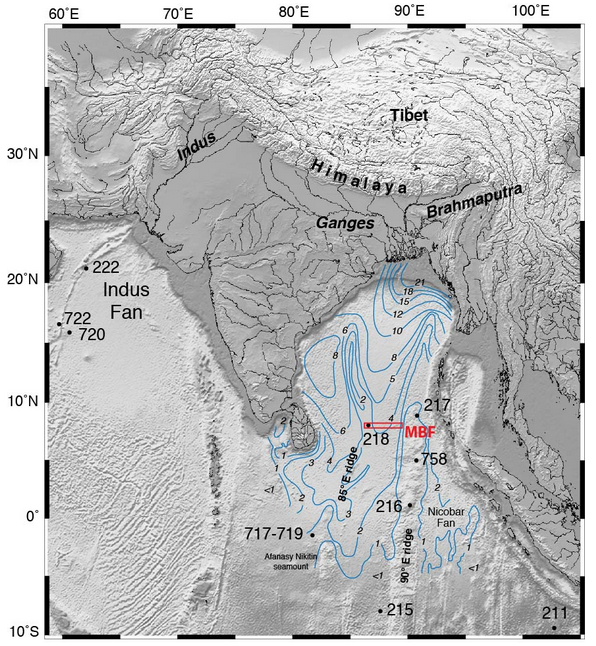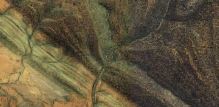This study in blues and greys and browns, this combination of fuzziness and sharp edges, where is it?
It’s where land and ocean meet and mingle. A place where mud and silt and sand pause half way along an incredible journey that links the destruction of mountains to the creation of new land.
It’s an aerial view of the sea offshore from the Sundarbans, a vast area of tidal mangrove forest in India and Bangladesh. Sitting in the eastern elbow of the Indian subcontinent this is where the water from the Ganges and Tsangpo-Bhramaputra rivers enters the sea.
What makes the picture interesting is the dynamic shifting patterns of the sediment under the water. Water that when madly dashing down-hill had the power to carry sediment, but now it’s reached the sea it slows down and the sediment starts to pile up. Tiny clay minerals that were happily floating in suspension in fresh-water suddenly clumped together and sank in the salty sea. The shape of the land here is caused by this process, plus the influence of the daily tides and the sinking of the ground as the sediment squashes down into itself. Fractally-frequent creeks and rivers snake their lazy way across near-flat terrain making it dangerously sensitive to changes in sea-level.
What is the sediment?
The sediment in this image came from the Himalayas. Some of came from near Mount Kailas and moved nearly 3,000km along the Tsangpo river tracing a line parallel to and north of the Himalayas. Cutting through the Himalayas at the Namche Barwa syntaxis the river cuts deep into the earth, eroding so deeply that the hot rocks beneath are flowing up to fill the hole, like jam oozing from a cut doughnut.
Often we are taught erosion as a gradual, calm almost civilised process. Not necessarily. Some of this sediment did indeed start as a small grain popped of an outcrop and rolled gently into a mountain stream. But more of it comes from boulders in glaciers scraping and scratching the rocks beneath, the resulting rock flour staining the glacial streams a milky blue. Or maybe from where the river cut a slope impossibly steep and a huge landslide smashed the rock into pieces. Or where the landslide dammed the river, until inevitably the water overtops it and a huge boulder-rolling crushing scouring flood sweeps down the valley.
Where the sediment came from
Sediment isn’t just generic stuff, it’s made of minerals, each with a character and a history of its own.
The sediment carries traces of the intense underground events that formed the mountains. Simple sand can be quartz crystals freed from ancient sandstones, born in the vanished Tethys ocean. Yet transformed in the meantime, crystals lattices rotated, grain boundaries switching and twisting as the rocks were heated and deformed.
More dramatic still is the story of the clay. Layers of silicates like illite or chlorite, packed higgley-piggledy with all manner of atoms, lazy and relaxed, suited for a soft low-pressure life on the surface. But these minerals are new, results of chemical weathering, a decline, a descent from what was once strong and pure. Metamorphic minerals forged in the mountain’s heart: sparkling muscovite; kyanite, face lined from the pressure; hot-headed sillimanite, bushels of fibres bursting out the guts of the biotite it was feeding on.
These are strong minerals, forged under intense conditions. But under the attack of water, oxygen and sunlight they turn back into the clay the originally formed from. Some metamorphic minerals can survive longer at the surface, garnet, zircon and others form a very small part of the sediment load, but one that can tell us a great deal about where they’ve been.
Where it’s going
The sediment patterning the sea-bed in the image above has not reached the end of its journey. Sediment that joined a river perched 5 kilometers above sea-level is still nearly the same height again above the vast deep plains of the Indian Ocean.
Sediment flows downhill under water just as well as it does on land. Submarine channels are formed by turbidity currents – fast flows of sediment-filled water that travel vast distances down into the deep ocean. These undersea rivers have banks and trace sinuous patterns on the surface just like their cousins above land.
For over 20 million years, sediment flowing into the ocean from the Himalayas has formed the Bengal fan, a triangular pile of sediment that is 3000 km long, filling nearly all the sea-floor between the Indian sub-continent and south east Asia.

Blue lines are thickness of sediment in the Bengal Fan. Image Source: IODP Red box is location of this year’s drilling.
This is no thin layer either. In places the pile of sediment is over 20 km thick. The oldest sediments are buried so deep they must now be metamorphic rocks.
The total volume of the fan has been estimated to be 12.5 million cubic kilometres. That’s enough sediment to cover the whole of Britain with a 100 km thick pile, or even the USA with over a kilometre.
Assuming most of the sediment came from the Himalayas, which have an area of a million square kilometres, this implies that since the mountains were formed around 12.5 km of rock has been eroded off the top. This makes sense – much of the High Himalaya is made of metamorphic rocks formed beneath the mountains and since exposed by erosion. .
Linking sea and mountain
This makes the fan a time-machine. Geologists who study the Himalayas, who want to understand its history, can use cores of sediment from the fan to understand what happened in the past. What metamorphic minerals were being washed off the mountains 20 million years ago? What age where they? Are there traces of the Monsoon (which is caused by the high Tibetan Plateau) at this time? The International Ocean Discovery Program (IODP) were drilling here earlier this year to answer exactly these questions.
The beautiful image we started with is from the boundary between land and sea, but the links between these two domains are many and important. Rocks that once sat kilometres above those now forming the modern High Himalaya now sit, shattered and decayed in the deep sea thousands of kilometres away. Erosion is focussed in the Himalaya partly due to monsoon rains, where moist air from the Indian Ocean is drawn onto the land by heating of air above the high mountains. Formation of the Indian Ocean crust pushed the Indian continent away from its location next to Africa to smash into Asia and form the mountains in the first place.
One day the plates will rearrange themselves and the Indian ocean will be destroyed and some of these rocks will once again find themselves on land, perhaps high in a mountain range waiting to go on another incredible journey back into the deep sea.




